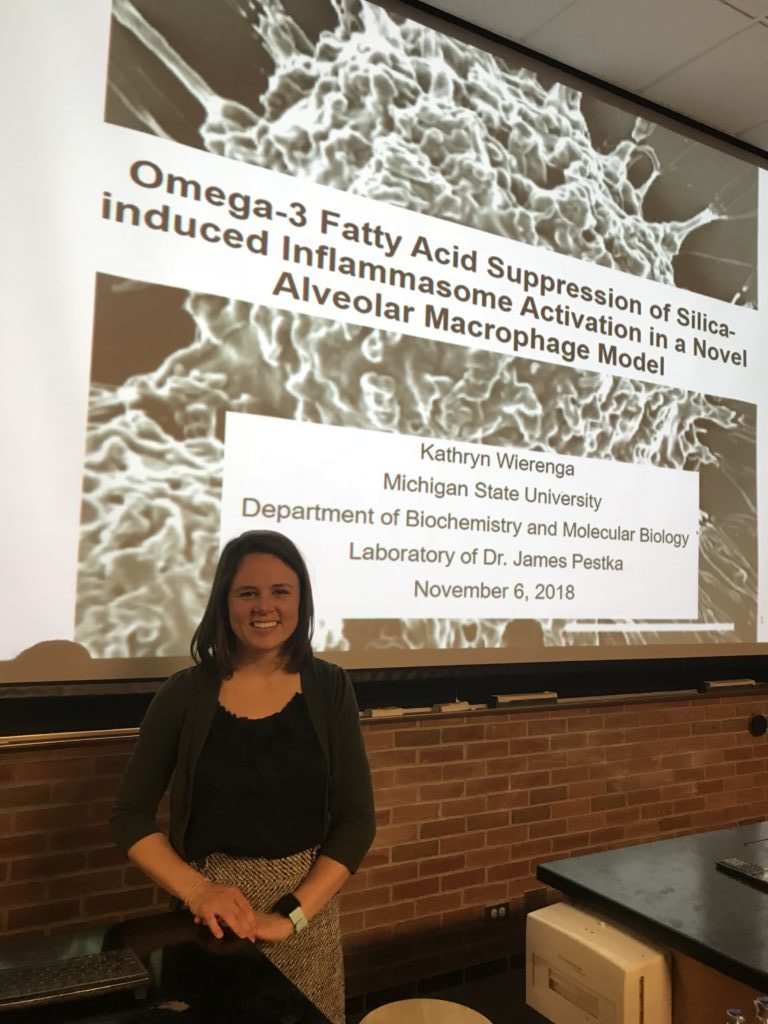
After earning her Bachelor of Science in chemistry, Kathryn Wierenga ’16 is now a Ph.D. candidate working in the laboratory of James J. Pestka, Ph.D. at Michigan State University in the Department of Biochemistry and Molecular Biology.
On Nov. 7, Wierenga came back to Hillsdale College and inspired students to attend graduate school through a proposal presentation of her thesis work.
Wierenga said the goal of her lab is to understand why Lupus develops, and the focus of her research will be understanding how docosahexaenoic acid and crystalline silica influence the progression of Lupus.
Lupus is a prototypical autoimmune disease which is characterized by systemic inflammation and a loss of self-tolerance, which means the immune system begins to attack itself. Wierenga said the development of lupus can be affected by an individual’s genetic makeup and can also be affected by the exposome.
“The exposome is anything we’re exposed,” Wierenga said. “That could include things we eat, such as the dietary fatty acid docosahexaenoic acid; it can also include things we inhale, such as the toxic stressor, crystalline silica.”
In order to understand the relationship between Lupus, docosahexaenoic acid, and crystalline silica, Wierenga will focus on the alveolar macrophage.
“The alveolar macrophage is an early responder to crystalline silica, and for this reason, I believe that by attenuating this early alveolar macrophage mediator response, we may then be able to suppress the downstream silica trigger to autoimmunity,” she said.
Her overall objective is to determine how the Omega-3 fatty acid docosahexaenoic acid influences silica induced toxicity in alveolar macrophages.
After gathering preliminary data, Wierenga formed a hypothesis for her thesis work.
“DHA and its metabolites protect alveolar macrophages from silica-induced toxicity by attenuating the priming step of inflammasome activation,” Wierenga said.
Wierenga said she hopes by attenuating the early alveolar macrophage mediated response, this may also suppress silica-triggered autoimmunity that occurs downstream.
Her research will address three specific questions about docosahexaenoic acid and its suspended particulate matter. In order to answer these questions, Wierenga has designed three separate experiments to conduct her research.
Courtney Meyet, an assistant professor of chemistry at Hillsdale College, said she was Wierenga’s thesis adviser when at Hillsdale. Wierenga worked alongside Meyet in the lab during her junior and senior year.
“I always knew that she was graduate school material, and she definitely had a mind for research — she had an intuition,” Meyet said. “She took her project, here at Hillsdale, in a direction I was not expecting her to take it.”
Meyet said she and Wierenga studied the synthesis of benzimidazoles, which are bioactive compounds. They put together an initial hypothesis, but the reaction didn’t behave the way they had expected. Despite this setback, Meyet said Wierenga decided to take a different approach to her research, and she began studying the formation rate of benzimidazole derivatives.
“I knew right then, she was definitely a researcher,” Meyet said. “Through her research here, she determined that she would much rather do research than go onto medical school.”
Now, Meyet said she considers Wierenga a colleague. She said it is always rewarding to see her former students go on to be successful in graduate school.
“It’s great to see them grow as chemists and scientists and to just continue to be part of that journey,” Meyet said. “I think that’s something very special that happens at an institution like Hillsdale College.”
Junior biochemistry major Carlin MacDonald-Gannon said she enjoyed Wierenga’s presentation and found it easy to follow. MacDonald-Gannon said she has learned about many of the techniques Wierenga described in her biochemistry courses.
“She’s taking a lot of things we’re learning here at Hillsdale and directly applying those skills to her experiment,” MacDonald-Gannon said. “For example, she talked about using ELISA, and I’ve been studying that, so I understood how and why she would do that.”
MacDonald-Gannon said she had never considered graduate school, but she was inspired by Wierenga’s research and looks forward to beginning some of her own research.
“Now, I’m excited to take my biochemistry lab next semester to see if I enjoy doing the processes I’ve learned about,” MacDonald-Gannon said.

